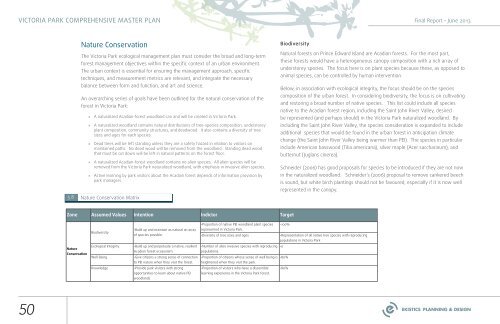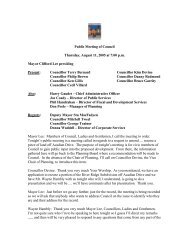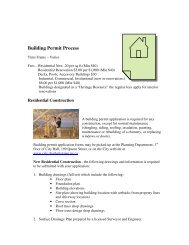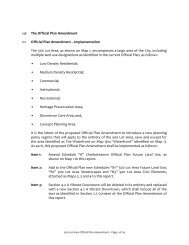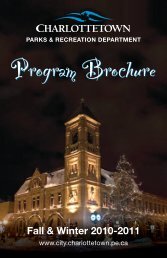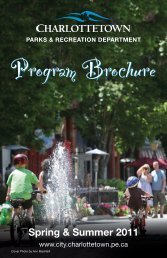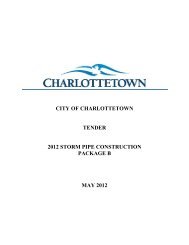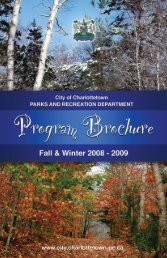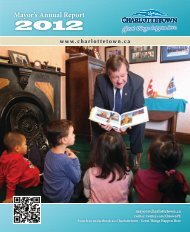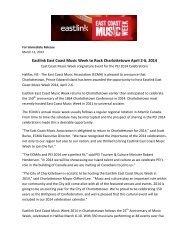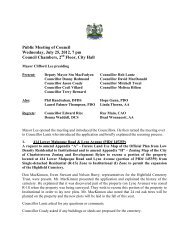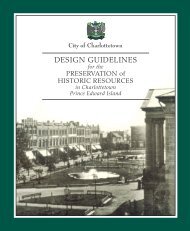Victoria_Park_Re port Final.pdf - City of Charlottetown
Victoria_Park_Re port Final.pdf - City of Charlottetown
Victoria_Park_Re port Final.pdf - City of Charlottetown
Create successful ePaper yourself
Turn your PDF publications into a flip-book with our unique Google optimized e-Paper software.
VICTORIA PARK COMPREHENSIVE MASTER PLAN<br />
<strong>Final</strong> <strong>Re</strong><strong>port</strong> • June 2013<br />
5.8<br />
Nature Conservation<br />
The <strong>Victoria</strong> <strong>Park</strong> ecological management plan must consider the broad and long-term<br />
forest management objectives within the specific context <strong>of</strong> an urban environment.<br />
The urban context is essential for ensuring the management approach, specific<br />
techniques, and measurement metrics are relevant, and integrate the necessary<br />
balance between form and function, and art and science.<br />
An overarching series <strong>of</strong> goals have been outlined for the natural conservation <strong>of</strong> the<br />
forest in <strong>Victoria</strong> <strong>Park</strong>:<br />
»»<br />
A naturalized Acadian-forest woodland can and will be created in <strong>Victoria</strong> <strong>Park</strong>.<br />
»»<br />
A naturalized woodland contains natural distributions <strong>of</strong> tree-species composition, understorey<br />
plant composition, community structures, and deadwood. It also contains a diversity <strong>of</strong> tree<br />
sizes and ages for each species.<br />
»»<br />
Dead trees will be left standing unless they are a safety hazard in relation to visitors on<br />
maintained paths. No dead wood will be removed from the woodland. Standing dead wood<br />
that must be cut down will be left in natural patterns on the forest floor.<br />
»»<br />
A naturalized Acadian-forest woodland contains no alien species. All alien species will be<br />
removed from the <strong>Victoria</strong> <strong>Park</strong> naturalized woodland, with emphasis in invasive alien species.<br />
»»<br />
Active learning by park visitors about the Acadian forest depends <strong>of</strong> information provision by<br />
park managers.<br />
Nature Conservation Matrix<br />
Biodiversity<br />
Natural forests on Prince Edward Island are Acadian forests. For the most part,<br />
these forests would have a heterogeneous canopy composition with a rich array <strong>of</strong><br />
understorey species. The focus here is on plant species because these, as opposed to<br />
animal species, can be controlled by human intervention.<br />
Below, in association with ecological integrity, the focus should be on the species<br />
composition <strong>of</strong> the urban forest. In considering biodiversity, the focus is on cultivating<br />
and restoring a broad number <strong>of</strong> native species. This list could include all species<br />
native to the Acadian forest region, including the Saint John River Valley, desired<br />
be represented (and perhaps should) in the <strong>Victoria</strong> <strong>Park</strong> naturalized woodland. By<br />
including the Saint John River Valley, the species consideration is expanded to include<br />
additional species that would be found in the urban forest in anticipation climate<br />
change (the Saint John River Valley being warmer than PEI). The species in particular<br />
include American basswood (Tilia americana), silver maple (Acer saccharinum), and<br />
butternut (Juglans cinerea).<br />
Schneider (2006) has good proposals for species to be introduced if they are not now<br />
in the naturalized woodland. Schneider’s (2006) proposal to remove cankered beech<br />
is sound, but white birch plantings should not be favoured, especially if it is now well<br />
represented in the canopy.<br />
Zone Assumed Values Intention Indictor Target<br />
Nature<br />
Conservation<br />
Biodiversity<br />
Ecological Integrity<br />
Well Being<br />
Knowledge<br />
•Pro<strong>port</strong>ion <strong>of</strong> native PEI woodland plant species •100%<br />
•Build up and maintain as natural an array<br />
<strong>of</strong> species possible.<br />
represented in <strong>Victoria</strong> <strong>Park</strong>.<br />
•Diversity <strong>of</strong> tree sizes and ages •<strong>Re</strong>presentation <strong>of</strong> all native tree species with reproducing<br />
populations in <strong>Victoria</strong> <strong>Park</strong><br />
•Build up and perpetuate a native, resilient<br />
Acadian forest ecosystem.<br />
•Give citizens a strong sense <strong>of</strong> connection<br />
to PEI nature when they visit the forest.<br />
•Provide park visitors with strong<br />
op<strong>port</strong>unities to learn about native PEI<br />
woodlands.<br />
•Number <strong>of</strong> alien invasive species with reproducing •0<br />
populations.<br />
•Pro<strong>port</strong>ion <strong>of</strong> citizens whose sense <strong>of</strong> well being is •80%<br />
heightened when they visit the park.<br />
•Pro<strong>port</strong>ion <strong>of</strong> visitors who have a discernible •80%<br />
learning experience in the <strong>Victoria</strong> <strong>Park</strong> forest.<br />
50


